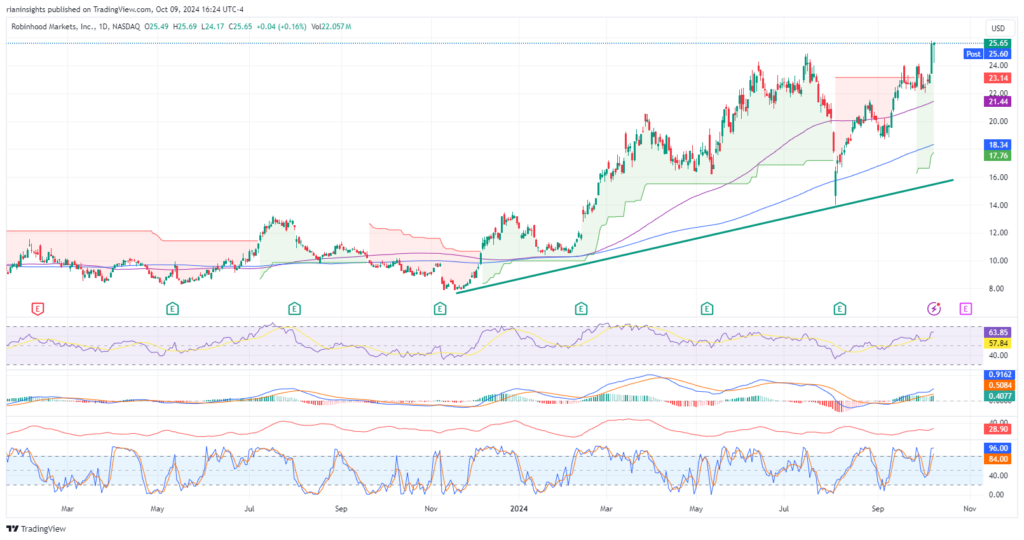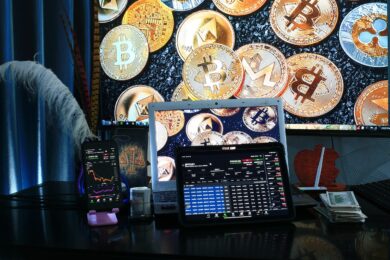
Cathie Wood offloads 1.5M Robinhood shares near 52-week high: should you consider selling?
- Cathie Wood sold 1.5M Robinhood shares, cashing at 52-week high.
- Investor day and product launches have driven recent stock momentum.
- Strong bull run; support at $22, stop loss at $18.60.
Cathie Wood’s ARK Invest made headlines on October 9, 2024 by offloading nearly 1.5 million shares of Robinhood Markets (NASDAQ: HOOD), cashing in on the stock’s recent surge to a 52-week high.
The sale came after Robinhood stock jumped 9.8%, driven by an announcement that the company will hold its first-ever investor day on December 4, 2024.
ARK’s flagship fund, ARK Innovation ETF, offloaded 1.09 million shares, while ARK Next Generation Internet ETF and ARK Fintech Innovation ETF sold 191,000 and 135,000 shares, respectively.
Despite this significant sale, Robinhood remains a major holding in ARK’s portfolios, signaling that the offload could be more of a profit-taking move rather than a complete exit.
Investor day sparks enthusiasm
Copy link to sectionRobinhood’s announcement of its investor day triggered a notable surge in its stock price, reaching $25.34, a 52-week high.
The company plans to outline its vision for the next decade, fueling optimism among investors.
This anticipation, coupled with Robinhood’s growing product portfolio, has investors eager to see how the company positions itself for long-term growth.
The stock, which had its IPO at $38 in July 2021, has struggled in the past but appears to be gaining momentum, especially with new product launches like crypto transfers in Europe and margin trading in the UK.
Recent launches
Copy link to sectionIn addition to the investor day announcement, Robinhood has made several strategic moves to expand its reach.
The company recently launched crypto transfers in Europe, allowing customers to deposit and withdraw over 20 cryptocurrencies.
This move is seen as a major step towards building an international presence.
Robinhood also plans to roll out margin trading in the UK, further targeting younger, tech-savvy retail investors.
The company’s focus on geographic expansion, combined with innovative products like the Gold Card and potential stablecoin ventures, suggests a robust growth strategy despite regulatory challenges.
Analysts’ mixed ratings
Copy link to sectionWhile Cathie Wood’s sale has raised questions, several analysts remain optimistic about Robinhood’s potential.
Barclays upgraded the stock to “Equal Weight” in September 2024, highlighting improvements in the company’s cost structure and product offerings.
Piper Sandler also upgraded Robinhood to “Overweight” in August 2024, citing the recent pullback in the stock as an attractive entry point.
Price targets vary, with Piper raising theirs to $23, while Deutsche Bank sees over 20% upside, particularly if market volatility continues into the US elections.
However, there are still concerns about valuation, with some analysts warning that the stock’s earnings growth may not yet justify its current market cap.
Q2 Earnings: A mixed bag
Copy link to sectionRobinhood’s Q2 2024 earnings report was a mixed bag. The company posted a GAAP EPS of $0.21, beating estimates by $0.06, and reported revenue of $682 million, up 40% year-over-year.
However, the platform saw a decline in monthly active users, dropping from 13.7 million in Q1 to 11.8 million in Q2.
This dip could signal user disengagement after the pandemic trading frenzy.
On the upside, average revenue per user (ARPU) increased by 35% year-over-year to $113, driven by robust options trading.
The company’s net interest revenue also grew by 22%, contributing to record net deposits of $13.2 billion in the quarter.
Potential risks and challenges
Copy link to sectionDespite the positive financials, Robinhood faces several challenges. Regulatory uncertainty surrounding its crypto operations, especially in Europe, could hamper growth in this segment.
Additionally, the platform’s recent settlement with the California Department of Justice over its crypto withdrawal ban from 2018-2022 underscores the ongoing scrutiny.
The company’s aggressive push into new products, such as its Gold Card and retirement accounts, comes with risks, especially as competition in the fintech space intensifies.
Valuation and future outlook
Copy link to sectionRobinhood is currently trading at roughly 15x forward EBITDA, which some analysts consider a reasonable valuation for a company in growth mode.
The firm’s cash position is strong, with over $4.5 billion in unrestricted cash and no debt, providing flexibility for further expansion.
The company’s EBITDA is expected to reach $1.2 billion by 2025, which, if achieved, would make the stock an attractive long-term investment.
Still, the volatility in crypto markets and the potential for lower trading activity remain risks that could affect profitability.
With the fundamentals in mind, it’s time to assess how the stock is behaving from a technical standpoint and see what insights the charts offer on Robinhood’s price trajectory.
Strong upward momentum pushing the stock to new heights
Copy link to sectionRobinhood’s stock has more than doubled in price so far this year and though it remains considerably lower than the lifetime highs made in August 2021, there’s no denying that the stock has started a new bull run.

Source: TradingView
Taking this strong upward momentum into account investors with a bullish outlook on the company can purchase the stock at current levels or on a pullback to $22 level with a stop loss of $18.60.
Short-term traders eyeing a possible shorting opportunity should refrain from shorting the stock unless it breaks and gives a daily closing below its 100-day moving average, which is currently at $21.7.
More industry news







